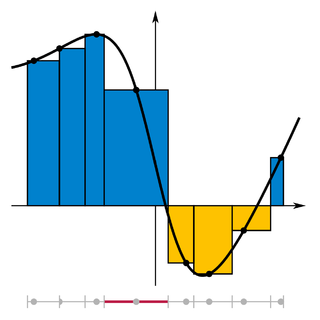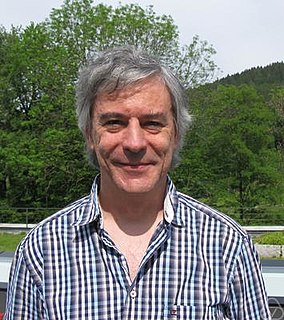Related Research Articles
Combinatorics is an area of mathematics primarily concerned with counting, both as a means and an end in obtaining results, and certain properties of finite structures. It is closely related to many other areas of mathematics and has many applications ranging from logic to statistical physics, from evolutionary biology to computer science, etc.

Discrete mathematics is the study of mathematical structures that are fundamentally discrete rather than continuous. In contrast to real numbers that have the property of varying "smoothly", the objects studied in discrete mathematics – such as integers, graphs, and statements in logic – do not vary smoothly in this way, but have distinct, separated values. Discrete mathematics therefore excludes topics in "continuous mathematics" such as calculus or Euclidean geometry. Discrete objects can often be enumerated by integers. More formally, discrete mathematics has been characterized as the branch of mathematics dealing with countable sets. However, there is no exact definition of the term "discrete mathematics." Indeed, discrete mathematics is described less by what is included than by what is excluded: continuously varying quantities and related notions.

In mathematics, a dynamical system is a system in which a function describes the time dependence of a point in a geometrical space. Examples include the mathematical models that describe the swinging of a clock pendulum, the flow of water in a pipe, and the number of fish each springtime in a lake.

In mathematics and abstract algebra, group theory studies the algebraic structures known as groups. The concept of a group is central to abstract algebra: other well-known algebraic structures, such as rings, fields, and vector spaces, can all be seen as groups endowed with additional operations and axioms. Groups recur throughout mathematics, and the methods of group theory have influenced many parts of algebra. Linear algebraic groups and Lie groups are two branches of group theory that have experienced advances and have become subject areas in their own right.
Ergodic theory is a branch of mathematics that studies statistical properties of deterministic dynamical systems; it is the study of ergodicity. In this context, statistical properties means properties which are expressed through the behavior of time averages of various functions along trajectories of dynamical systems. The notion of deterministic dynamical systems assumes that the equations determining the dynamics do not contain any random perturbations, noise, etc. Thus, the statistics with which we are concerned are properties of the dynamics.
In mathematics, a measure-preserving dynamical system is an object of study in the abstract formulation of dynamical systems, and ergodic theory in particular. Measure-preserving systems obey the Poincaré recurrence theorem, and are a special case of conservative systems. They provide the formal, mathematical basis for a broad range of physical systems, and, in particular, many systems from classical mechanics as well as systems in thermodynamic equilibrium.

In mathematics, a partition of an interval [a, b] on the real line is a finite sequence x0, x1, x2, ..., xn of real numbers such that

Yakov Grigorevich Sinai is a Russian mathematician known for his work on dynamical systems. He contributed to the modern metric theory of dynamical systems and connected the world of deterministic (dynamical) systems with the world of probabilistic (stochastic) systems. He has also worked on mathematical physics and probability theory. His efforts have provided the groundwork for advances in the physical sciences.
In mathematics, symbolic dynamics is the practice of modeling a topological or smooth dynamical system by a discrete space consisting of infinite sequences of abstract symbols, each of which corresponds to a state of the system, with the dynamics (evolution) given by the shift operator. Formally, a Markov partition is used to provide a finite cover for the smooth system; each set of the cover is associated with a single symbol, and the sequences of symbols result as a trajectory of the system moves from one covering set to another.

In mathematics, an interval exchange transformation is a kind of dynamical system that generalises circle rotation. The phase space consists of the unit interval, and the transformation acts by cutting the interval into several subintervals, and then permuting these subintervals. They arise naturally in the study of polygonal billiards and in area-preserving flows.
In mathematics, ergodicity expresses the idea that a point of a moving system, either a dynamical system or a stochastic process, will eventually visit all parts of the space that the system moves in, in a uniform and random sense. This implies that the average behavior of the system can be deduced from the trajectory of a "typical" point. Equivalently, a sufficiently large collection of random samples from a process can represent the average statistical properties of the entire process. Ergodicity is a property of the system; it is a statement that the system cannot be reduced or factored into smaller components. Ergodic theory is the study of systems possessing ergodicity.
In mathematics, a conservative system is a dynamical system which stands in contrast to a dissipative system. Roughly speaking, such systems have no friction or other mechanism to dissipate the dynamics, and thus, their phase space does not shrink over time. Precisely speaking, they are those dynamical systems that have a null wandering set: under time evolution, no portion of the phase space ever "wanders away", never to be returned to or revisited. Alternately, conservative systems are those to which the Poincaré recurrence theorem applies. An important special case of conservative systems are the measure-preserving dynamical systems.

In the mathematical theory of dynamical systems, an irrational rotation is a map

Alexandra Bellow is a Romanian-American mathematician, who has made contributions to the fields of ergodic theory, probability and analysis.
Arithmetic dynamics is a field that amalgamates two areas of mathematics, dynamical systems and number theory. Classically, discrete dynamics refers to the study of the iteration of self-maps of the complex plane or real line. Arithmetic dynamics is the study of the number-theoretic properties of integer, rational, p-adic, and/or algebraic points under repeated application of a polynomial or rational function. A fundamental goal is to describe arithmetic properties in terms of underlying geometric structures.
In mathematics a translation surface is a surface obtained from identifying the sides of a polygon in the Euclidean plane by translations. An equivalent definition is a Riemann surface together with a holomorphic 1-form.

Anton V. Zorich is a Russian mathematician at the Institut Mathématiques de Jussieu. He received his Ph.D. from Moscow State University under the supervision of Sergei Novikov.
Giovanni Forni is an Italian mathematician at the University of Maryland known for his research in dynamical systems.
The Michael Brin Prize in Dynamical Systems, abbreviated as the Brin Prize, is awarded to mathematicians who have made outstanding advances in the field of dynamical systems and are within 14 years of their PhD. The prize is endowed by and named after Michael Brin, whose son Sergey Brin, is a co-founder of Google. Michael Brin is a retired mathematician at the University of Maryland and a specialist in dynamical systems.
References
- 1 2 3 Faculty profile, Rice University, retrieved 2015-03-01.
- ↑ Todd, Hannah. "Former math department chair passes away". Rice Thresher. Retrieved 29 September 2016.
- ↑ William A. Veech at the Mathematics Genealogy Project
- ↑ Hunt, B. R.; Kaloshin, V. Yu. (2010), "Prevalence", in Broer, H.; Takens, F.; Hasselblatt, B. (eds.), Handbook of Dynamical Systems, Volume 3, Elsevier, pp. 43–88, ISBN 9780080932262 . See in particular p. 51.
- ↑ Bufetov, Alexander I. (2006), "Decay of correlations for the Rauzy-Veech-Zorich induction map on the space of interval exchange transformations and the central limit theorem for the Teichmüller flow on the moduli space of abelian differentials", Journal of the American Mathematical Society, 19 (3): 579–623, arXiv: math/0506222 , doi:10.1090/S0894-0347-06-00528-5, MR 2220100, S2CID 15755696 .
- ↑ Smillie, John; Weiss, Barak (2008), "Veech's dichotomy and the lattice property", Ergodic Theory and Dynamical Systems, 28 (6): 1959–1972, doi:10.1017/S0143385708000114, MR 2465608 .
- ↑ Edelson, Edward (August 1991), "Buckyball: the magic molecule", Popular Science : 52–57, 87. The quote is on p. 55.
- ↑ Ball, Philip (1996), Designing the Molecular World: Chemistry at the Frontier, Princeton Science Library, Princeton University Press, p. 46, ISBN 9780691029009 .
- ↑ Review of A Second Course in Complex Analysis by E. Hille, MR 0220903.
- ↑ Wenzel, H., "W. A. Veech, A Second Course in Complex Analysis", Book Reviews, Journal of Applied Mathematics and Mechanics , 48 (7): 502–503, Bibcode:1968ZaMM...48..502W, doi:10.1002/zamm.19680480725 .
- ↑ Stenger, Allen (April 24, 2008), "A Second Course in Complex Analysis, William A. Veech", MAA Reviews, Mathematical Association of America .
- ↑ List of Fellows of the American Mathematical Society, retrieved 2015-03-01.